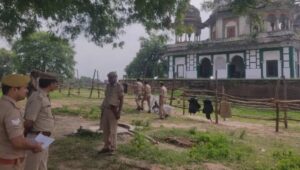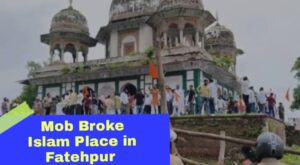Communal Tensions: Fatehpur Tomb Vandalism in Uttarpradesh
Communal Tensions: Fatehpur Tomb Vandalism in Uttarpradesh. This Muslim Tomb in Fatehpur district of Uttarpradesh is long drawn religious battle field for Mandir Vs Masjid Claims from both sides.
What is the context of Fatehpur Tomb Vandalism in Uttarpradesh ?
On August 11, 2025, a large group of Hindu activists allegedly broke through police barricades at the 200-year-old mausoleum in Abu Nagar, Fatehpur, Uttar Pradesh, claiming it was originally a Hindu temple.
They hoisted saffron flags, chanted religious slogans and partially damaged the structure.
An FIR was registered against 10 named individuals—including local BJP and Bajrang Dal leaders—and around 150 unidentified participants under multiple sections including unlawful assembly, rioting, trespass on burial grounds, and damage to public property.
Police have launched an ongoing investigation to identify and hold the perpetrators accountable.

Official Records vs. Activist Claims On Fatehpur Tomb Vandalism Case
According to revenue records, the structure at Khasra No. 753 is registered as “Maqbara Mangi”, a tomb—indicating official recognition as a mausoleum.
However, local Hindu organizations—including the Math Mandir Sanrakshan Sangharsh Samiti, BJP district leadership, VHP, and Bajrang Dal—assert that the site was once a Thakurdwara temple dedicated to Lord Shiva or Krishna, citing lotus and trident motifs within the structure as evidence.
These organizations had earlier submitted a memorandum to district authorities seeking permission to clean, beautify, and perform prayers at the site ahead of Janmashtami. Allegedly, after receiving no response, they organized the protest that escalated into unrest.
Political Fallout and Reactions after Fatehpur Tomb Vandalism Incident
The incident triggered heated debates in the Uttar Pradesh Assembly, with the Samajwadi Party accusing the government of deliberately disrupting communal harmony. The Chief Minister’s office denied any administrative complicity in the events.
Akilesh Yadav, SP leader, criticized the BJP for indulging in divisive politics, stating:
“Only when society is divided and hatred is spread will the BJP be successful in politics.”
Congress MP Imran Masood condemned the disparity in response, noting that if the roles were reversed, the state’s reaction would have been swift and severe.
Religious voices also condemned the act: Mohammad Naseem, National Secretary of the Ulama Council, faulted the move for distorting history, threatening communal relations while pointing out that the tomb is clearly marked as such in government records.
Why This Matters: Ongoing Similar Incidents
This is part of a wider pattern across India where heritage sites are becoming flashpoints:
1. Nagpur Violence (March 2025)
- Clashes erupted when right-wing groups demanded removal of Aurangzeb’s tomb, leading to injuries and arrests.
- The ASI eventually installed protective sheets around the structure.
2. Sambhal Mosque Tension (Nov 2024)
- A court-ordered ASI survey of a mosque in Sambhal sparked protests due to claims it was built over a demolished temple, resulting in fatalities and political uproar.
3. Dharmasthala Mass Burial Allegations (July–August 2025)
- An investigation is underway into shocking claims of mass clandestine burials at a temple in Karnataka.
- While unrelated, the episode highlights the volatile mix of religious sites and communal tensions.
4. kashi Vishwanath Temple and Mosque Case in Uttarpradesh
5. Bhojsthal complex Issue of Goddess Sarasvati Temple Vs Mosque in Madhyapradesh.
These incidents underscore the fragile intersection of religion, history, and politics, often fueled by social media amplification, and the importance of maintaining social harmony.

What’s Next? What Can Happen after Fatehpur Tomb Vandalism Incident
1. Police Actions: Identification of suspects, arrests, and potentially filing of charge sheets.
2. Judicial Process: Courts may evaluate petitions, examine revenue records, and settle the heritage dispute.
3. Social Calm and harmony: Local leaders and administration must ensure tensions don’t spiral further—no repeat of a “Babri-like” tragedy.
Dark History of Temple Demolition by Mughals
This raises questions around the Places of Worship Act, 1991, which protects the status of religious sites as they existed in 1947 (except the Babri case).
But there are many sources and codified history that Barbarian Mughals destroyed thousands of Hindu Temples and built Islamic Mosques on those broken Temples.
Hindu community deserves their worship places back and hence such incidents occurs. But Hindu community should use legal method just like Ram Mandir Vs Babri Mosque case rather than doing such mob attacks.
Final Words on Fatehpur Tomb Vandalism Case
The Fatehpur tomb-versus-temple dispute is a microcosm of India’s larger communal and political dynamics. With communal fault lines deepening, swift legal action, responsible leadership, and informed public discourse are vital to prevent escalation and preserve both heritage and harmony.
Read Also: ICICI Bank Rises Minimum balance amount spark Controversy
